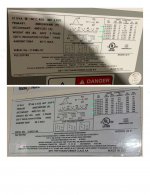MTW
Senior Member
- Location
- SE Michigan
If you figure out the photo upload, send one for each transformer for comparison.
No it s not an adjustable.Do you have an adjustable 200 amp breaker
both tags are now posted, thanks!if you copy the picture to your clipboard, you may be able to just past it in your reply.

Yes I did not quite understand the 3rd coil having a different connection either.My assessment is somewhat different than MTW's.
I agree on the point that the newer transformer is built to a higher efficiency standard and may have higher inrush.
I disagree that inrush will be higher if the supply voltage is lower. Rated running current will be higher at the lower supply voltage but primary impedance is unchanged so magnetization inrush should go down.
I disagree that the 3rd coil on the secondary has a different connection. The fact that all secondary coils have a full set of taps makes it clear that the tap numbers should be applied to all of the secondary coils.
I absolutely agree that the transformer connection needs to be evaluated. Something is wrong when the lower kVA higher efficiency unit draws greater idle current with the secondary disconnected.
My guess: the primary taps are not correctly connected.
My wild ass hunch: two of the primary coils are connected in the low voltage configuration, one in the high voltage configuration. The unbalance is causing increased inrush and idle current.
Jon
240 service voltageYour service voltage 240 or 208?

